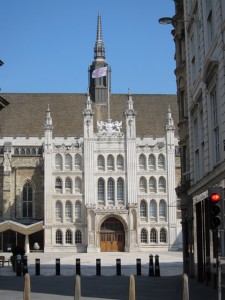
Chronicler and Windsor Herald Charles Wriothesley records:
“This yeare, the fyrst daye of December, was arrigned at the Guyld Hall in London Thomas Culpepper, one of the Gentleman of the Kinges Pryvie Chamber, and Frauncis Dorand, gentleman, for high treason against the Kinges Majestie in mysdemeanor with the Quene, as appeered by theyr inditements which they confessed, and had their judgments to be drawne, hanged, and quartered […]”1
Eustace Chapuys, the imperial ambassador, wrote to Emperor Charles V of proceedings:
“This same clerk was again sent on St. Andrews’ day to tell me that the day after Colpeper and Durem (Durham) would be tried for high treason, begging me to send one of my secretaries to be present at the trial. The same notice and invitation has been handed round to the ambassador of France, to the Venetian Secretary, and to the gentleman of the duke of Clèves, who is still here. All the privy councillors witnessed the trial, which, after a long discussion lasting six hours, ended in the condemnation of the two abovementioned gentlemen, who were sentenced to be hung and quartered as traitors. Durem (Durham) did confess having known the Queen familiarly before she was either betrothed or promised to the King; but said he did not know that there was any wrong in that, inasmuch as they were then engaged to each other. Colpeper persisted in denying the guilt of which he was accused, maintaining that he never solicited or had anything to do with her; on the contrary, it was she who had importuned him through Mme. de Rochefort, requesting him (Colpeper) to go and meet her in a retired place in Lincolnshire, to which she appointed him, and that on that occasion he (Colpeper) having kept the appointment, she herself told him, as she had on the first instance sent him word through Mme. Rochefort, that she pined for him, and was actually dying of love for his person. It is thought that both will be beheaded to-day. Dame de Rochefort would have been sentenced at the same time had she not, on the third day after her imprisonment, been seized with a fit of madness (frenesi) by which her brain is affected.
True is it that now and then she recovers her reason, and that the King takes care that his own physicians visit her daily, for he desires her recovery chiefly that he may afterwards have her executed as an example and warning to others.
The Queen is still at Syon House, and it is believed that the King, to show clemency in her case, will make no innovation whatever with regard to her, or do more than he has hitherto done until Parliament meets and decides what her fate is to be.”2
Francis Dereham and Thomas Culpeper were executed at Tyburn on 10th December 1541. Culpeper’s sentence had been commuted to beheading, because of his status, but Dereham had to suffer the full traitor’s death. Culpeper was buried at St Sepulchre Holborn.
On 21st January 1542, a bill of attainder against Catherine Howard and Lady Jane Rochford was introduced into the House of Lords. According to this bill, the women were guilty of treason and could be punished without there being any need for a trial. It received the King’s assent on 11th February 1542. As you can see from Chapuys’ letter, there were concerns about Lady Rochford’s mental state. She was nursed back to health at Russell House on the Strand, the London residence of Sir John Russell, Lord Admiral, and his wife Anne, under the supervision of the King’s own doctors, before she was taken to the Tower of London on 9th February 1542. Catherine was taken by barge from Syon to the Tower of London the following day and both women were beheaded on 13th February 1542.
Also, on this day in history, in 1530, Margaret of Austria, Duchess of Savoy, died at Mechelen. Anne Boleyn spent a year at her court and you can click here to read more about this.
Notes and Sources
- Wriothesley, Charles (1875) A chronicle of England during the reigns of the Tudors, from A.D. 1485 to 155, p. 131.
- Calendar of State Papers, Spain, Volume 6 Part 1, 1538-1542, 209.